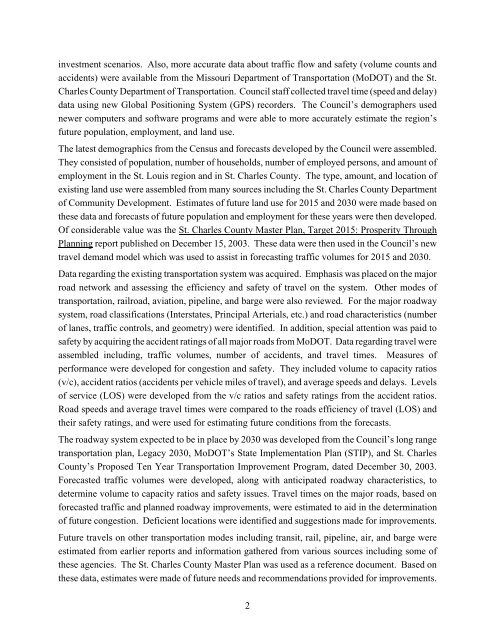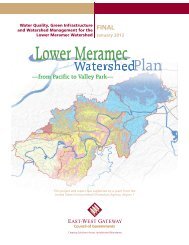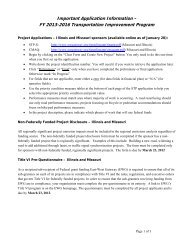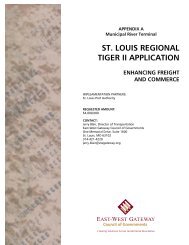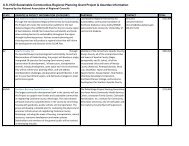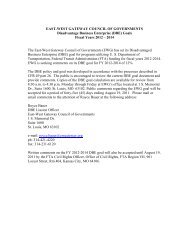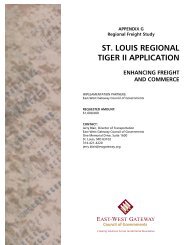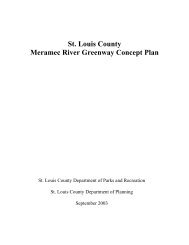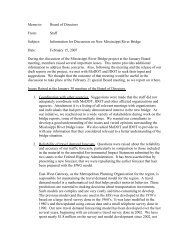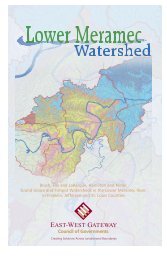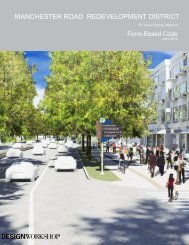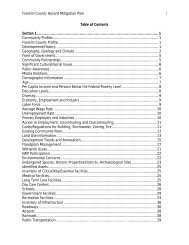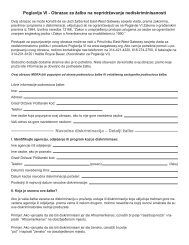St. Charles County Transportation Plan 2030 - East-West Gateway ...
St. Charles County Transportation Plan 2030 - East-West Gateway ...
St. Charles County Transportation Plan 2030 - East-West Gateway ...
You also want an ePaper? Increase the reach of your titles
YUMPU automatically turns print PDFs into web optimized ePapers that Google loves.
investment scenarios. Also, more accurate data about traffic flow and safety (volume counts and<br />
accidents) were available from the Missouri Department of <strong>Transportation</strong> (MoDOT) and the <strong>St</strong>.<br />
<strong>Charles</strong> <strong>County</strong> Department of <strong>Transportation</strong>. Council staff collected travel time (speed and delay)<br />
data using new Global Positioning System (GPS) recorders. The Council’s demographers used<br />
newer computers and software programs and were able to more accurately estimate the region’s<br />
future population, employment, and land use.<br />
The latest demographics from the Census and forecasts developed by the Council were assembled.<br />
They consisted of population, number of households, number of employed persons, and amount of<br />
employment in the <strong>St</strong>. Louis region and in <strong>St</strong>. <strong>Charles</strong> <strong>County</strong>. The type, amount, and location of<br />
existing land use were assembled from many sources including the <strong>St</strong>. <strong>Charles</strong> <strong>County</strong> Department<br />
of Community Development. Estimates of future land use for 2015 and <strong>2030</strong> were made based on<br />
these data and forecasts of future population and employment for these years were then developed.<br />
Of considerable value was the <strong>St</strong>. <strong>Charles</strong> <strong>County</strong> Master <strong>Plan</strong>, Target 2015: Prosperity Through<br />
<strong>Plan</strong>ning report published on December 15, 2003. These data were then used in the Council’s new<br />
travel demand model which was used to assist in forecasting traffic volumes for 2015 and <strong>2030</strong>.<br />
Data regarding the existing transportation system was acquired. Emphasis was placed on the major<br />
road network and assessing the efficiency and safety of travel on the system. Other modes of<br />
transportation, railroad, aviation, pipeline, and barge were also reviewed. For the major roadway<br />
system, road classifications (Interstates, Principal Arterials, etc.) and road characteristics (number<br />
of lanes, traffic controls, and geometry) were identified. In addition, special attention was paid to<br />
safety by acquiring the accident ratings of all major roads from MoDOT. Data regarding travel were<br />
assembled including, traffic volumes, number of accidents, and travel times. Measures of<br />
performance were developed for congestion and safety. They included volume to capacity ratios<br />
(v/c), accident ratios (accidents per vehicle miles of travel), and average speeds and delays. Levels<br />
of service (LOS) were developed from the v/c ratios and safety ratings from the accident ratios.<br />
Road speeds and average travel times were compared to the roads efficiency of travel (LOS) and<br />
their safety ratings, and were used for estimating future conditions from the forecasts.<br />
The roadway system expected to be in place by <strong>2030</strong> was developed from the Council’s long range<br />
transportation plan, Legacy <strong>2030</strong>, MoDOT’s <strong>St</strong>ate Implementation <strong>Plan</strong> (STIP), and <strong>St</strong>. <strong>Charles</strong><br />
<strong>County</strong>’s Proposed Ten Year <strong>Transportation</strong> Improvement Program, dated December 30, 2003.<br />
Forecasted traffic volumes were developed, along with anticipated roadway characteristics, to<br />
determine volume to capacity ratios and safety issues. Travel times on the major roads, based on<br />
forecasted traffic and planned roadway improvements, were estimated to aid in the determination<br />
of future congestion. Deficient locations were identified and suggestions made for improvements.<br />
Future travels on other transportation modes including transit, rail, pipeline, air, and barge were<br />
estimated from earlier reports and information gathered from various sources including some of<br />
these agencies. The <strong>St</strong>. <strong>Charles</strong> <strong>County</strong> Master <strong>Plan</strong> was used as a reference document. Based on<br />
these data, estimates were made of future needs and recommendations provided for improvements.<br />
2


